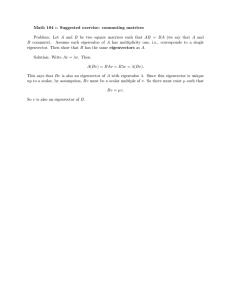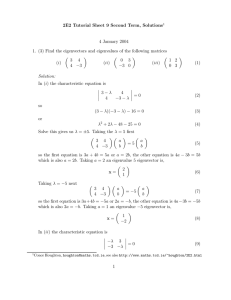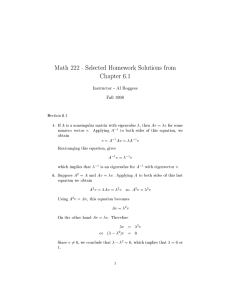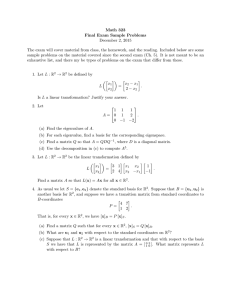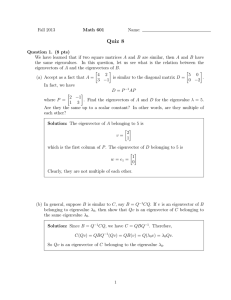Worksheet 16: Eigenvalues and eigenvectors
advertisement
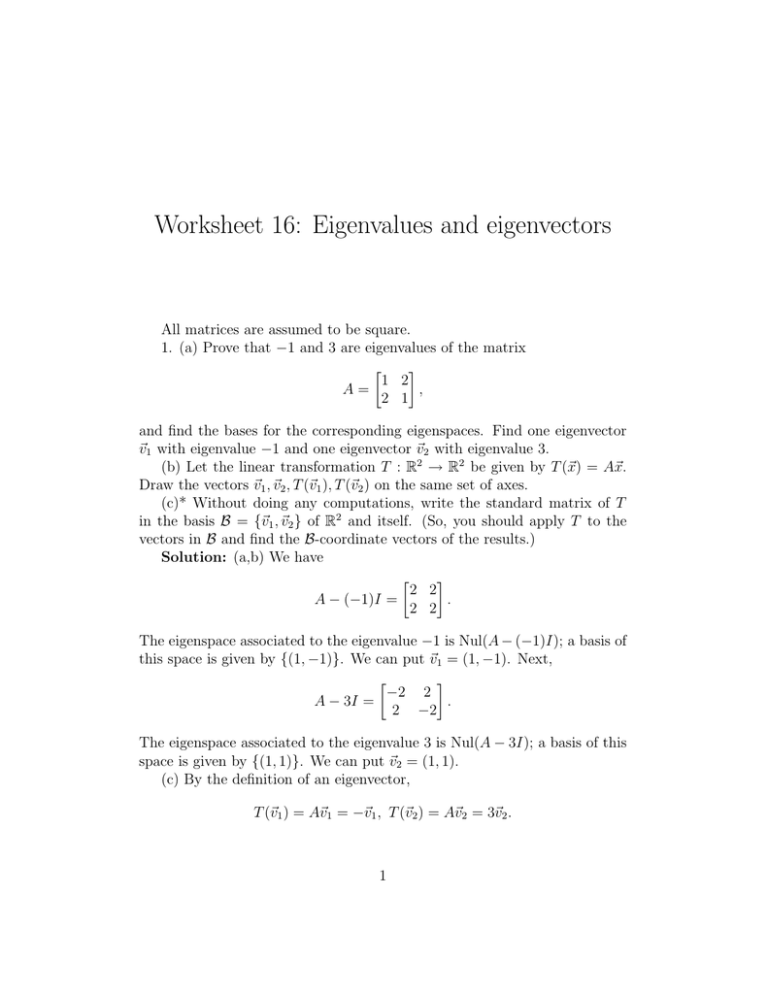
Worksheet 16: Eigenvalues and eigenvectors
All matrices are assumed to be square.
1. (a) Prove that −1 and 3 are eigenvalues of the matrix
1 2
A=
,
2 1
and find the bases for the corresponding eigenspaces. Find one eigenvector
~v1 with eigenvalue −1 and one eigenvector ~v2 with eigenvalue 3.
(b) Let the linear transformation T : R2 → R2 be given by T (~x) = A~x.
Draw the vectors ~v1 , ~v2 , T (~v1 ), T (~v2 ) on the same set of axes.
(c)* Without doing any computations, write the standard matrix of T
in the basis B = {~v1 , ~v2 } of R2 and itself. (So, you should apply T to the
vectors in B and find the B-coordinate vectors of the results.)
Solution: (a,b) We have
2 2
A − (−1)I =
.
2 2
The eigenspace associated to the eigenvalue −1 is Nul(A − (−1)I); a basis of
this space is given by {(1, −1)}. We can put ~v1 = (1, −1). Next,
−2 2
A − 3I =
.
2 −2
The eigenspace associated to the eigenvalue 3 is Nul(A − 3I); a basis of this
space is given by {(1, 1)}. We can put ~v2 = (1, 1).
(c) By the definition of an eigenvector,
T (~v1 ) = A~v1 = −~v1 , T (~v2 ) = A~v2 = 3~v2 .
1
Therefore, the coordinate vectors are
−1
0
[T (~v1 )]B =
, [T (~v2 )]B =
;
0
3
the matrix of T in the basis B is diagonal:
−1 0
[T ]B =
.
0 3
2–4. Find the eigenvalues and the bases of the corresponding eigenspaces
of the following matrices: (Use Theorem 5.1.1 to find the eigenvalues.)
1 2
,
0 1
1 2
,
0 2
1 0 0
0 1 0 .
0 0 2
Answers: (2) Eigenvalue 1, eigenspace basis {(1, 0)} (3) Eigenvalue 1,
eigenspace basis {(1, 0)}; eigenvalue 2, eigenspace basis {(2, 1)} (4) Eigenvalue 1, eigenspace basis {(1, 0, 0), (0, 1, 0)}; eigenvalue 2, eigenspace basis
{(0, 0, 1)}.
5. Lay, 5.1.25.
Solution: Since λ is an eigenvalue of A, there exists a vector ~x 6= 0
such that A~x = λ~x. Multiplying both sides of this equation by A−1 , we get
~x = λA−1~x. Since ~x 6= 0, it follows that λ 6= 0; we divide both sides by λ to
get A−1~x = λ−1~x; so, ~x is an eigenvector of A−1 with eigenvalue λ−1 .
6. Show that if A2 = I, then the only possible eigenvalues of A are −1
and 1. (Hint: suppose that ~x 6= 0 satisfies A~x = λ~x.)
Solution: Take ~x 6= 0 such that A~x = λ~x; we need to prove that λ = 1
or λ = −1. We have
~x = A2~x = A(A~x) = A(λ~x) = λ(A~x) = λ2~x;
since ~x 6= 0, we get λ2 = 1.
2
7. Lay, 5.1.32.
Solution: Any nonzero vector lying on the axis of rotation will be an
eigenvector with eigenvalue 1. There are no other (real) eigenvectors.
8. Assume that P is invertible. Prove that ~x is an eigenvector of P −1 AP
if and only if P ~x is an eigenvector of A. Prove that the eigenvalues of A and
P −1 AP are the same.
Solution: ~x is an eigenvector of P −1 AP with eigenvalue λ if and only if
P −1 AP ~x = λ~x. Multiplying both sides by P , we see that this is equivalent
to AP ~x = λP ~x; that is, to P ~x being an eigenvector of A with eigenvalue λ.
(We have P ~x 6= 0 since ~x 6= 0 and P is invertible.) Now, λ is an eigenvalue
of A if there is a corresponding eigenvector; the reasoning above shows that
there exists an eigenvector of A with eigenvalue λ if and only if there exists
an eigenvector of P −1 AP with the same eigenvalue; thus, the eigenvalues of
A and P −1 AP are the same.
3

